After an unexpected solar storm event in the late night of September 2, that extended well into the morning of September 3, many scientists believe that such solar activities will now continue to increase till the equinox on September 23. During equinoxes, the Earth's magnetic poles (north and south) are at right angles to the solar wind. This makes the solar wind stronger, which can cause stronger magnetic storms. To increase the troubles, a new sunspot, AR3421, has also emerged directly in view of the Earth. The sunspot contains a mixed polarity magnetic field that can often create powerful solar flare eruptions. In case a large enough coronal mass ejection (CME) is released during the event, it can trigger a destructive solar storm.,
Solar storm prediction! X-class solar flares likely today, may spark blackouts
17.08.2023 - 08:43 / tech.hindustantimes.com / Class / Storm
A new sunspot has entered the Earth-facing side of the Sun, and it appears to be crackling with solar flares. Luckily, so far it has not exploded, but it cannot be said just how long it will stay the same way. And perhaps that's why today's solar storm forecast has included a chance of an X-class solar flare eruption as well as the possibility of radio blackouts due to solar winds passing. It remains to be seen whether any eruptions today can release a coronal mass ejection (CME) towards the Earth and cause a further solar storm threat.
Space weather physicist Tamitha Skov posted on her X account to give a detailed solar storm prediction. According to the forecast, there is a 35 percent chance for an M-class solar flare eruption (R1-R2) and a 5 percent chance for an X-class solar flare (R3). Additionally, there is a 10 percent risk of a radiation storm hitting the Earth as well.
Earlier today, SpaceWeatherLive, an X account dedicated to reporting live space weather tweeted, “03:15 UTC - Type II Radio Emission. Begin Time: 17/08/2023 02:29 UTC. Estimated Velocity: 253km/sec”.
Radio emissions are electromagnetic waves that are thermally charged and are released from the Sun at the time of solar activity. Type II is a moderate emission, but it can still spark shortwave radio blackouts that can affect ham radio operators, drone pilots, mariners, and those who rely on shortwave frequencies.
Luckily, today it does not appear that the Earth is being targeted by a CME that can spark a solar storm event. But if these predicted solar flares go off, things can change quickly.
How NOAA's DSCOVR satellite monitors the Sun
NOAA monitors solar storms and Sun's behavior using its DSCOVR satellite which became operational in 2016. The recovered data is then run through the Space Weather Prediction Center and the final analysis is prepared. The different measurements are done on temperature, speed, density, degree of orientation, and frequency of the solar particles.
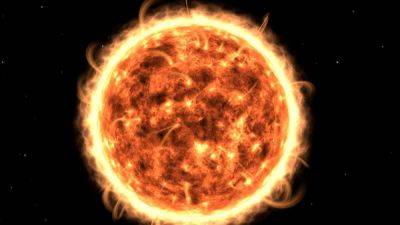
Solar storm warning issued for today; geomagnetic storm may spark auroras, power cuts
A solar storm is heading for Earth today and the Space Weather Prediction Center (SWPC) of the National Weather Service has issued a Geomagnetic Storm Watch for today, September 3, 2023. On this day, Earth may experience a G1 level geomagnetic storm, the mildest on the 1-5 scale. While this geomagnetic storm could cause some aurora displays and minor disruptions in electrical grids, navigation, and communication systems, it is not expected to be a severe event, according to spaceweather.com
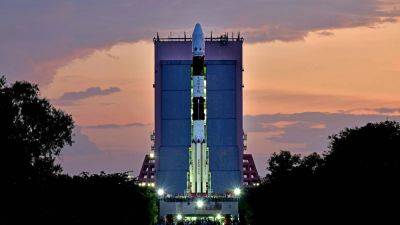
Aditya-L1 will study effect of solar flares and wind, says former ISRO scientist
The day has finally come! Indian Space Research Organisation (ISRO) is prepared to launch the next space-based mission, Aditya-L1 today, September 2, 2023, at 11.50 AM. After a successful moon mission, the space agency is ready to contribute towards the unfolding of the Sun's environment. Recently, in an interview, former ISRO scientist, Tapan Misra said about the mission that studying our Sun's solar flares and the solar wind is essential to understanding how they affect the weather. Know more about the mission's objectives as per ISRO scientist:

Aditya-L1 mission to unravel the secrets of solar storms that destroyed Elon Musk’s satellites
In just a few hours, India's first-ever space mission to study the Sun and the space weather, Aditya-L1, will take off. Once it completes its long journey to its destination of the L1 Lagrange point, it will begin observing the Sun using the seven payloads that will collect data from it. Apart from observing the Sun, its corona, and its dynamic patterns, it will also study space weather, in particular the effect of solar winds and coronal mass ejection (CME) in causing solar storms. Understanding this phenomenon is crucial, as it contains the destructive potential to damage all satellites in space. In fact, it did exactly that in February 2022 when Elon Musk's SpaceX lost 40 of its Starlink satellites to solar storms.

Man films awesome aurora on a plane! Video is viral; know how a solar storm sparks this light show
Auroras, commonly known as Northern Lights, are a rare sky phenomenon that result in stunning streaks of colourful light in the sky near the polar regions. However, there are instances where these flashing lights have also appeared across the world, especially if the solar storm that causes them is of strong intensity. Recently, people on a flight to Europe bore witness to a mesmerizing aurora that was snapped by a user, and the social media post has gone viral since then.
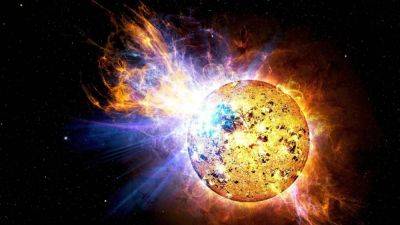
Solar storm ALERT! Magnetic filament erupts on the Sun; CME to strike tomorrow, NASA says
The last ten days have been quite uneventful in terms of Earth-directed solar activity. This was strange given there are still 6 sunspot regions present on our planet's side of the Sun. And even as the Sun nears the peak of its solar cycle in 2025, the last month has passed without any significant eruptions. But with September coming in, solar activities have again picked up. Recently, a massive magnetic filament erupted in the northern hemisphere of the Sun. The eruption resulted in a large cloud of coronal mass ejection (CME) being hurled at the Earth. NASA has confirmed that the CME will strike our planet on September 2.
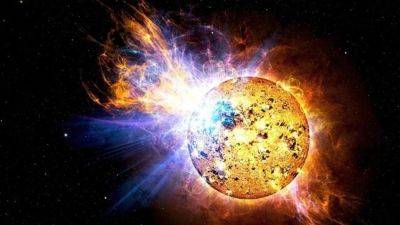
Massive sunspot set to spark dangerous M-class solar flares directed at Earth, says NASA
As we approach the solar maximum, the Sun's output is expected to increase in the coming months. As per NASA, the solar minimum occurred in 2019, which also marked the start of the solar maximum, a period where we could see the greatest number of sunspots. It is expected to peak in 2025 and the Sun could unleash CMEs, solar flares, solar storms, and other particles towards Earth with potentially disastrous consequences. Astonishingly, experts have revealed that the Sun has already exceeded the predicted number of sunspots that were expected in the current solar maximum.

Solar storm warning: NASA's Mars rover snaps Sun turning, spies dangerous sunspot facing Earth
In an intriguing celestial observation, NASA's Perseverance Rover on Mars has captured a striking view of a massive sunspot, signalling a region of heightened solar solar activity on the far side of the Sun. This sunspot is rotating to face the Earth and the likelihood of a solar storm has just increased manifold.
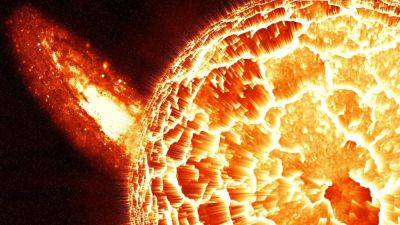
Want to go to Mars? Know the solar flare danger that can even kill you
After yesterday's success of the Chandrayaan-3 mission, the excitement in the astronomy community is at an all-time high. Many are already wondering about other new achievements India and the world can unlock. And among the huge bucket list of ideas about space exploration, one thing has always remained on top - a manned mission to Mars could pave the way for building a colony on the red planet. However, a NASA scientist has warned us that this dream may just not be possible in the near future with the current technology that we have. Why? It's because the radiation from solar flares and coronal mass ejections (CME) will kill us long before we ever reach Mars.
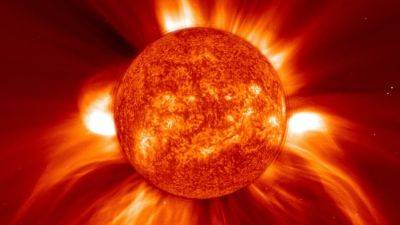
All about the fiery explosions on the Sun - know what are solar flares and CME
Over the past few months, as the volatility of the Sun increases, solar flares have been in the news constantly. Do you know what they are and how can they affect us? The Sun has been putting on a dazzling display of its power, and it's only going to get more exciting as we approach the peak of Solar Cycle 25, expected around 2025. But what's all the fuss about? Well, the Sun has some incredible phenomena like solar flares and coronal mass ejections (CMEs), that can affect us here on Earth. They are said to even affect electric infrastructure on Earth.
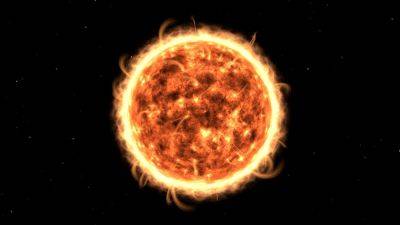
Fiery Earth-facing sunspots could unleash M-class solar flares
The Sun has been displaying its might over the last few months, and its activity is expected to increase as we move towards the peak of Solar Cycle 25, which is likely to be in 2025. During its 11-year cycle, the Sun unleashes CMEs, solar flares, solar storms, and other high energy particles which can damage electric infra on Earth. Although scientists now have the technology to predict most of these events, this cycle's activity has already exceeded the maximum threshold which was predicted earlier.

Sun spits out solar flare so terrifying it is comparable to a billion bombs
In a recent occurrence, the Sun displayed unusual tranquility, following a period of potentially hazardous solar storm activity directed towards Earth the previous week. Solar physicist Keith Strong shared observations revealing that despite the calm on Earth, the Sun's surface was far from peaceful. And it proved that with a super-powerful solar flare.
